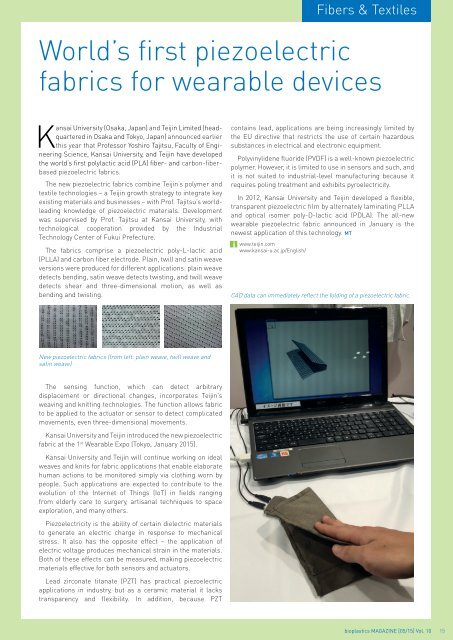Issue 05/2015
bioplasticsMAGAZINE_1505
bioplasticsMAGAZINE_1505
Create successful ePaper yourself
Turn your PDF publications into a flip-book with our unique Google optimized e-Paper software.
Fibers & Textiles<br />
World’s first piezoelectric<br />
fabrics for wearable devices<br />
Kansai University (Osaka, Japan) and Teijin Limited (headquartered<br />
in Osaka and Tokyo, Japan) announced earlier<br />
this year that Professor Yoshiro Tajitsu, Faculty of Engineering<br />
Science, Kansai University, and Teijin have developed<br />
the world’s first polylactic acid (PLA) fiber- and carbon-fiberbased<br />
piezoelectric fabrics.<br />
The new piezoelectric fabrics combine Teijin’s polymer and<br />
textile technologies – a Teijin growth strategy to integrate key<br />
existing materials and businesses – with Prof. Tajitsu’s worldleading<br />
knowledge of piezoelectric materials. Development<br />
was supervised by Prof. Tajitsu at Kansai University, with<br />
technological cooperation provided by the Industrial<br />
Technology Center of Fukui Prefecture.<br />
The fabrics comprise a piezoelectric poly-L-lactic acid<br />
(PLLA) and carbon fiber electrode. Plain, twill and satin weave<br />
versions were produced for different applications: plain weave<br />
detects bending, satin weave detects twisting, and twill weave<br />
detects shear and three-dimensional motion, as well as<br />
bending and twisting.<br />
contains lead, applications are being increasingly limited by<br />
the EU directive that restricts the use of certain hazardous<br />
substances in electrical and electronic equipment.<br />
Polyvinylidene fluoride (PVDF) is a well-known piezoelectric<br />
polymer. However, it is limited to use in sensors and such, and<br />
it is not suited to industrial-level manufacturing because it<br />
requires poling treatment and exhibits pyroelectricity.<br />
In 2012, Kansai University and Teijin developed a flexible,<br />
transparent piezoelectric film by alternately laminating PLLA<br />
and optical isomer poly-D-lactic acid (PDLA). The all-new<br />
wearable piezoelectric fabric announced in January is the<br />
newest application of this technology. MT<br />
www.teijin.com<br />
www.kansai-u.ac.jp/English/<br />
CAD data can immediately reflect the folding of a piezoelectric fabric.<br />
New piezoelectric fabrics (from left: plain weave, twill weave and<br />
satin weave)<br />
The sensing function, which can detect arbitrary<br />
displacement or directional changes, incorporates Teijin’s<br />
weaving and knitting technologies. The function allows fabric<br />
to be applied to the actuator or sensor to detect complicated<br />
movements, even three-dimensional movements.<br />
Kansai University and Teijin introduced the new piezoelectric<br />
fabric at the 1 st Wearable Expo (Tokyo, January <strong>2015</strong>).<br />
Kansai University and Teijin will continue working on ideal<br />
weaves and knits for fabric applications that enable elaborate<br />
human actions to be monitored simply via clothing worn by<br />
people. Such applications are expected to contribute to the<br />
evolution of the Internet of Things (IoT) in fields ranging<br />
from elderly care to surgery, artisanal techniques to space<br />
exploration, and many others.<br />
Piezoelectricity is the ability of certain dielectric materials<br />
to generate an electric charge in response to mechanical<br />
stress. It also has the opposite effect – the application of<br />
electric voltage produces mechanical strain in the materials.<br />
Both of these effects can be measured, making piezoelectric<br />
materials effective for both sensors and actuators.<br />
Lead zirconate titanate (PZT) has practical piezoelectric<br />
applications in industry, but as a ceramic material it lacks<br />
transparency and flexibility. In addition, because PZT<br />
bioplastics MAGAZINE [<strong>05</strong>/15] Vol. 10 15


















